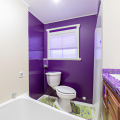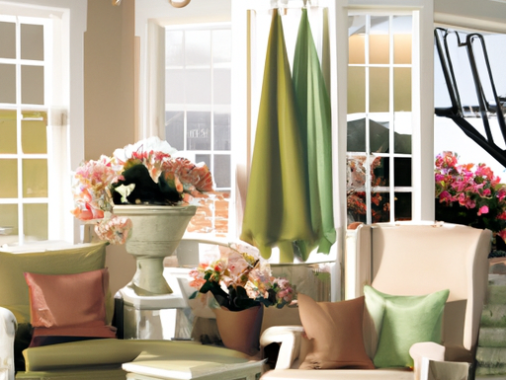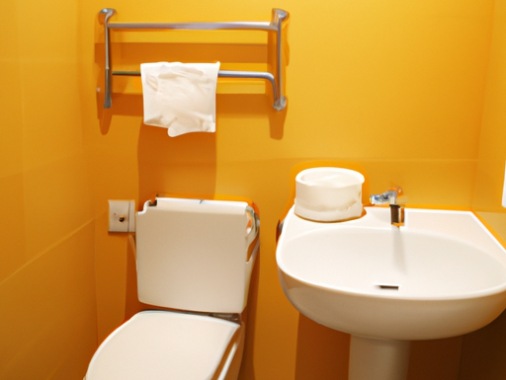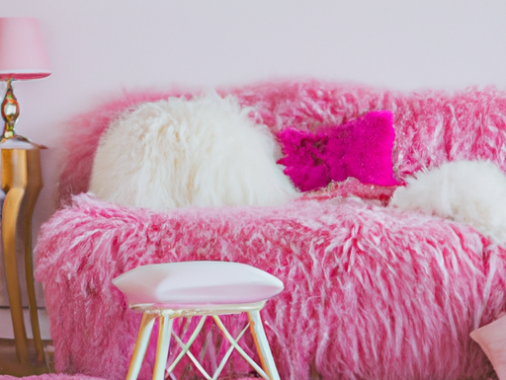-
Table of Contents
- Introduction
- How to Choose the Perfect Accent Wall Color for Your Dining Room
- 10 Creative Ideas for Accent Walls in Your Dining Room
- The Pros and Cons of Having an Accent Wall in Your Dining Room
- How to Incorporate Accent Walls into Your Dining Room Design
- The Benefits of Using Wallpaper for Your Dining Room Accent Wall
- Tips for Creating a Unique Accent Wall in Your Dining Room
- How to Use Lighting to Enhance Your Dining Room Accent Wall
- Q&A
- Conclusion
Introduction
Welcome to the world of accent wall dining rooms! An accent wall is a great way to add a unique and stylish touch to any dining room. Whether you’re looking to create a bold statement or just add a subtle hint of color, an accent wall can be the perfect way to make your dining room stand out. With the right design and color choices, you can create a beautiful and inviting atmosphere for your family and friends to enjoy. In this guide, we’ll explore the different types of accent walls, the best colors to use, and how to create the perfect accent wall for your dining room.
How to Choose the Perfect Accent Wall Color for Your Dining Room
When it comes to choosing the perfect accent wall color for your dining room, there are a few key factors to consider. First, consider the overall color scheme of the room. If the room is already painted in a neutral color, such as white or beige, then you can choose a bolder color for the accent wall. If the room is already painted in a bold color, such as red or blue, then you may want to choose a more subtle color for the accent wall.
Second, consider the size of the room. If the room is small, then you may want to choose a lighter color for the accent wall. This will help to make the room appear larger and more open. If the room is large, then you can choose a darker color for the accent wall. This will help to create a cozy and intimate atmosphere.
Third, consider the furniture and decor in the room. If the furniture and decor are light in color, then you may want to choose a darker color for the accent wall. This will help to create a contrast between the furniture and the wall. If the furniture and decor are dark in color, then you may want to choose a lighter color for the accent wall. This will help to create a balance between the furniture and the wall.
Finally, consider the lighting in the room. If the room is well-lit, then you may want to choose a lighter color for the accent wall. This will help to create a bright and airy atmosphere. If the room is dimly lit, then you may want to choose a darker color for the accent wall. This will help to create a more intimate and cozy atmosphere.
By considering these factors, you can easily choose the perfect accent wall color for your dining room. With the right color, you can create a beautiful and inviting atmosphere that will make your dining room a favorite gathering spot for family and friends.
10 Creative Ideas for Accent Walls in Your Dining Room
1. Wallpaper: Wallpaper is a great way to add texture and color to your dining room. Choose a pattern that complements the rest of the room and create a stunning accent wall.
2. Paint: Paint is a classic way to create an accent wall. Choose a bold color that stands out from the rest of the room and create a focal point.
3. Wood Paneling: Wood paneling is a great way to add warmth and texture to your dining room. Choose a wood that complements the rest of the room and create a cozy atmosphere.
4. Mirrors: Mirrors are a great way to add light and depth to your dining room. Choose a large mirror and hang it on the accent wall to create a stunning focal point.
5. Wall Art: Wall art is a great way to add personality to your dining room. Choose a piece of art that reflects your style and hang it on the accent wall to create a unique look.
6. Wallpaper Murals: Wallpaper murals are a great way to add a unique touch to your dining room. Choose a mural that reflects your style and create a stunning accent wall.
7. Wall Decals: Wall decals are a great way to add color and texture to your dining room. Choose a decal that reflects your style and create a unique look.
8. Wallpaper Borders: Wallpaper borders are a great way to add a touch of whimsy to your dining room. Choose a border that complements the rest of the room and create a fun accent wall.
9. Wall Stencils: Wall stencils are a great way to add a unique touch to your dining room. Choose a stencil that reflects your style and create a stunning accent wall.
10. Wallpaper Accents: Wallpaper accents are a great way to add texture and color to your dining room. Choose an accent that complements the rest of the room and create a beautiful accent wall.
The Pros and Cons of Having an Accent Wall in Your Dining Room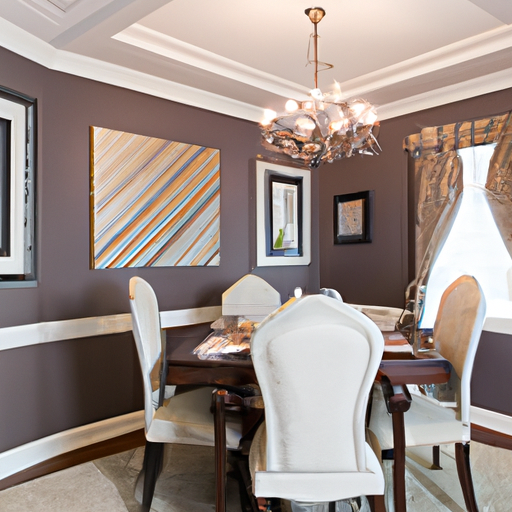
The idea of having an accent wall in your dining room is an attractive one, as it can add a unique and stylish touch to the room. However, there are both pros and cons to consider before making this decision.
Pros
One of the main advantages of having an accent wall in your dining room is that it can be used to create a focal point in the room. An accent wall can be used to draw attention to a particular feature, such as a fireplace or a piece of artwork. It can also be used to create a sense of depth and dimension in the room.
Another benefit of having an accent wall is that it can be used to add color and texture to the room. An accent wall can be painted in a bold color or covered with a textured wallpaper to create a unique look.
Cons
One of the drawbacks of having an accent wall in your dining room is that it can be difficult to match the color and texture of the wall with the rest of the room. If the accent wall is too bold or too textured, it can be difficult to coordinate with the other elements in the room.
Another potential downside of having an accent wall is that it can make the room feel smaller. An accent wall can make the room feel more cramped and closed in, which can be an issue if the room is already small.
In conclusion, having an accent wall in your dining room can be a great way to add style and interest to the room. However, it is important to consider the pros and cons before making this decision, as it can be difficult to match the color and texture of the wall with the rest of the room, and it can also make the room feel smaller.
How to Incorporate Accent Walls into Your Dining Room Design
When it comes to designing a dining room, incorporating an accent wall can be a great way to add a unique touch to the space. An accent wall is a wall that stands out from the other walls in the room, usually because of its color, texture, or pattern. Accent walls can be used to create a focal point in the room, draw attention to a particular area, or simply add a touch of personality to the space.
When incorporating an accent wall into your dining room design, there are a few things to consider. First, decide what type of wall you want to use. You can choose from a variety of materials, such as wood, stone, brick, wallpaper, or paint. Each material has its own unique look and feel, so it’s important to choose one that fits with the overall design of the room.
Next, decide on the color or pattern of the accent wall. If you’re using paint, you can choose a bold color that stands out from the other walls in the room. If you’re using wallpaper, you can choose a pattern that complements the other elements in the room. If you’re using wood or stone, you can choose a color or texture that adds warmth and texture to the space.
Finally, consider how the accent wall will be used. If you’re using it to create a focal point in the room, you may want to choose a bold color or pattern that stands out from the other walls. If you’re using it to draw attention to a particular area, you may want to choose a subtle color or pattern that blends in with the other walls.
By incorporating an accent wall into your dining room design, you can add a unique touch to the space and create a beautiful and inviting atmosphere. With the right materials and colors, you can create a stunning accent wall that will be the perfect addition to your dining room.
The Benefits of Using Wallpaper for Your Dining Room Accent Wall
Wallpaper is an excellent choice for creating an accent wall in your dining room. An accent wall is a great way to add visual interest to a room and can be used to create a focal point or to draw attention to a particular area. Wallpaper is a great choice for an accent wall because it is available in a wide variety of colors, patterns, and textures, allowing you to create a unique look that reflects your personal style.
Using wallpaper for an accent wall in your dining room can provide a number of benefits. First, wallpaper is a great way to add texture and depth to a room. Wallpaper can be used to create a variety of looks, from subtle and sophisticated to bold and dramatic. Wallpaper can also be used to create a focal point in the room, such as a feature wall behind the dining table.
Wallpaper is also a great way to add color to a room. Wallpaper is available in a wide range of colors, allowing you to create a look that is both vibrant and inviting. Wallpaper can also be used to create a sense of warmth and coziness in the room, making it a great choice for a dining room.
Wallpaper is also a great choice for an accent wall because it is relatively easy to install and maintain. Wallpaper is available in a variety of materials, including vinyl, fabric, and paper, and can be easily applied to a wall with wallpaper paste. Wallpaper is also easy to clean and maintain, making it a great choice for a dining room.
In conclusion, wallpaper is an excellent choice for creating an accent wall in your dining room. Wallpaper is available in a wide variety of colors, patterns, and textures, allowing you to create a unique look that reflects your personal style. Wallpaper is also easy to install and maintain, making it a great choice for a dining room.
Tips for Creating a Unique Accent Wall in Your Dining Room
1. Choose a Bold Color: Select a color that stands out from the rest of the room. Consider a bright hue such as red, yellow, or orange to create a dramatic effect.
2. Incorporate Textures: Add texture to the wall by using a variety of materials such as wood, stone, or tile. This will create an interesting visual effect and add depth to the room.
3. Add Wallpaper: Wallpaper is a great way to add a unique pattern or texture to the wall. Consider a bold pattern or a subtle texture to create a one-of-a-kind look.
4. Hang Artwork: Hang artwork on the wall to create a focal point. Choose pieces that reflect your style and complement the room’s color palette.
5. Install Shelves: Install shelves on the wall to display decorative items or to store items such as dishes or glassware.
6. Add Lighting: Install lighting fixtures on the wall to create a warm and inviting atmosphere. Consider sconces, pendant lights, or wall-mounted lamps.
7. Hang Mirrors: Hang mirrors on the wall to create the illusion of a larger space. Mirrors also reflect light and create a beautiful effect.
8. Install a Wallpaper Mural: Install a wallpaper mural to create a unique and eye-catching accent wall. Choose a mural that reflects your style and complements the room’s color palette.
How to Use Lighting to Enhance Your Dining Room Accent Wall
Lighting is an important element in any room, and the dining room is no exception. When used correctly, lighting can help to create a warm and inviting atmosphere in the dining room, as well as highlight any accent walls. Here are some tips on how to use lighting to enhance your dining room accent wall.
1. Choose the Right Fixture: The type of lighting fixture you choose will depend on the size and shape of your dining room. For a larger room, consider using a chandelier or pendant light to create a dramatic effect. For a smaller room, wall sconces or recessed lighting may be a better option.
2. Consider the Color of the Wall: The color of the wall will also affect the type of lighting you choose. If the wall is a light color, such as white or cream, then a bright light fixture will help to create a warm and inviting atmosphere. If the wall is a darker color, such as navy or black, then a softer light fixture may be more appropriate.
3. Place the Fixture Strategically: The placement of the light fixture is also important. If the wall is a focal point in the room, then the light fixture should be placed in a way that draws attention to it. If the wall is more of an accent, then the light fixture should be placed in a way that highlights it without being too overpowering.
4. Use Dimmer Switches: Dimmer switches are a great way to control the amount of light in the room. This allows you to adjust the lighting depending on the mood you want to create.
By following these tips, you can use lighting to enhance your dining room accent wall and create a warm and inviting atmosphere. With the right lighting, your dining room can be transformed into a beautiful and inviting space.
Q&A
1. What is an accent wall?
An accent wall is a wall in a room that is painted a different color than the other walls in the room, usually to create a focal point or to add visual interest.
2. What colors are best for an accent wall in a dining room?
The best colors for an accent wall in a dining room depend on the overall color scheme of the room. Generally, colors that contrast with the other walls in the room work best. For example, if the other walls are a light color, a dark color for the accent wall can create a dramatic effect.
3. How do I choose the right color for my accent wall?
When choosing the right color for an accent wall, consider the overall color scheme of the room. If the other walls are a neutral color, a bold color can be used for the accent wall to create a dramatic effect. If the other walls are already bold, a more subtle color can be used for the accent wall to create a more subtle effect.
4. What type of paint should I use for my accent wall?
When painting an accent wall, it is important to use a high-quality paint that is designed for the specific surface you are painting. For example, if you are painting a wall with drywall, use a paint specifically designed for drywall.
5. How do I make sure my accent wall looks good?
When painting an accent wall, it is important to use a high-quality paint and to take the time to properly prepare the wall before painting. Additionally, it is important to use a consistent technique when painting the wall to ensure a professional-looking finish.
6. What other design elements can I use to enhance my accent wall?
In addition to painting an accent wall, there are many other design elements that can be used to enhance the look of the wall. For example, adding a wallpaper border, stenciling, or hanging artwork can all be used to create a unique look.
7. Are there any tips for creating an accent wall in a dining room?
When creating an accent wall in a dining room, it is important to consider the overall color scheme of the room. Additionally, it is important to use a high-quality paint and to take the time to properly prepare the wall before painting. Finally, adding other design elements such as wallpaper borders, stenciling, or artwork can help to create a unique look.
Conclusion
The accent wall in a dining room can be a great way to add a unique and stylish touch to the room. It can be used to create a focal point, add a pop of color, or simply to make the room more interesting. With the right design and color, an accent wall can be a great way to make a dining room stand out and create a unique and inviting atmosphere.
